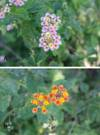Resumen
Lantana is currently one of the top 10 most troublesome weeds in Florida. Although it is still sold as an ornamental, commercial varieties are sterile and considered to be non-invasive. It can quickly invade disturbed sites by producing plant toxins in its roots and stems, which either slow the growth of other plants or totally remove them. These leaf toxins are damaging to grazing animals. If animals consume the leaves, they often begin to show symptoms of skin peeling or cracking. Once animals show these symptoms, there is little or no treatment that can reverse the process. Although lantana's leaves are poisonous, its berries are not. Birds readily consume the fruit and disperse the seed. This 2-page fact sheet was written by J. Ferrell, B. Sellers, and E. Jennings, and published by the UF Department of Agronomy, February 2012.
Citas
USDA, NRCS. 2012. Plants Database: Lantana camara Plants Profile. Accessed February 23, 2012. http://plants.usda.gov/java/county?state_name=Florida&statefips=12&symbol=LACA2.

